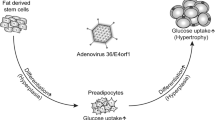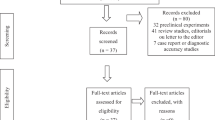Abstract
Objectives:
Infection with specific pathogens may lead to increased adiposity: a specific adiposity-promoting effect of Ad36 human adenovirus, without the involvement of neurological mechanisms, was reported. The aim of this study is to investigate whether non-diabetic patients with earlier Ad36 infection show greater degrees of overweight obesity, of Insulin Resistance (IR), assessed by homoeostasis-model assessment (HOMA), and/or of other related factors. Moreover, the relationship, if any, among these factors and an earlier Ad36 infection, and the hypothesis of a mechanism involving IR are investigated.
Subjects:
Ad36 seropositivity is assessed in 68 obese and 135 non-obese subjects, along with body composition, HOMA and laboratory investigations.
Results:
Age, body mass index (BMI), waist–hip ratio, blood pressure, insulin, HOMA and triglycerides are significantly greater in the Ad36 seropositive group. Ad36 seropositivity, along with HOMA and total cholesterol, explains BMI variance. No Ad36 seropositivity effect to HOMA could be envisaged by the same statistical model.
Conclusion:
A significant association of Ad36 seropositivity with obesity and with essential hypertension in human beings is suggested by our study; this association is mostly significant in women. Our results do not support that any Ad36 adipogenic adenovirus effect is operating in human obesity through an insulin-resistance-related mechanism. Ad36 seropositive status could also be a hallmark of a clinical-metabolic profile possibly preceding obesity and diabetes in non-obese patients.
This is a preview of subscription content, access via your institution
Access options
Subscribe to this journal
Receive 12 print issues and online access
$259.00 per year
only $21.58 per issue
Buy this article
- Purchase on Springer Link
- Instant access to full article PDF
Prices may be subject to local taxes which are calculated during checkout

Similar content being viewed by others
References
Lyons MJ, Faust IM, Hemmes RB, Buskirk DR, Hirsch J, Zabriskie JB . A virally induced obesity syndrome in mice. Science 1982; 216: 82–85.
Atkinson RL . Could viruses contribute to the worldwide epidemic of obesity? Int J Pediatr Obes 2008; 3 (Suppl 1): 37–43.
Greenway F . Virus-induced obesity. Am J Physiol Regul Integr Comp Physiol 2006; 290: R188–R189.
Atkinson RL, Dhurandhar NV, Allison DB, Bowen RL, Israel BA, Albu JB et al. Human adenovirus-36 is associated with increased body weight and paradoxical reduction of serum lipids. Int J Obes (Lond) 2005; 29: 281–286.
Whigham LD, Israel BA, Atkinson RL . Adipogenic potential of multiple human adenoviruses in vivo and in vitro in animals. Am J Physiol Regul Integr Comp Physiol 2006; 290: R190–R194.
So PW, Herlihy AH, Bell JD . Adiposity induced by adenovirus 5 inoculation. Int J Obes (Lond) 2005; 29: 603–606.
Christakis NA, Fowler JH . The spread of obesity in a large social network over 32 years. N Engl J Med 2007; 357: 370–379.
Cohen-Cole E, Fletcher JM . Is obesity contagious? Social networks vs. environmental factors in the obesity epidemic. J Health Econ 2008; 27: 1382–1387.
Skilton MR, Sieveking DP, Harmer JA, Franklin J, Loughnan G, Nakhla S et al. The effects of obesity and non-pharmacological weight loss on vascular and ventricular function and structure. Diabetes Obes Metab 2008; 10: 874–884.
Niswender KD, Beech BM . Obesity: increasing awareness of novel environmental factors. Diabetes 2008; 57: 1786–1787.
Trovato GM, Catalano D, Martines GF, Spadaro D, Di Nuovo S . Psychological stress measure in type 2 diabetes. Eur Rev Med Pharmacol Sci 2006; 10: 69–74.
McLaughlin T, Schweitzer P, Carter S, Yen CG, Lamendola C, Abbasi F et al. Persistence of improvement in insulin sensitivity following a dietary weight loss programme. Diabetes Obes Metab 2008; 10: 1186–1194.
Catalano D, Trovato GM, Martines GF, Randazzo M, Tonzuso A . Bright liver, body composition and insulin resistance changes with nutritional intervention: a follow-up study. Liver Int 2008; 28: 1280–1287.
Pasarica M, Shin AC, Yu M, Ou Yang HM, Rathod M, Jen KL et al. Human adenovirus 36 induces adiposity, increases insulin sensitivity, and alters hypothalamic monoamines in rats. Obesity 2006; 14: 1905–1913.
Rogers PM, Mashtalir N, Rathod MA, Dubuisson O, Wang Z, Dasuri K et al. Metabolically favorable remodeling of human adipose tissue by human adenovirus type 36. Diabetes 2008; 57: 2321–2331.
Hayashi T, Boyko EJ, McNeely MJ, Leonetti DL, Kahn SE, Fujimoto WY . Visceral adiposity, not abdominal subcutaneous fat area, is associated with an increase in future insulin resistance in Japanese Americans. Diabetes 2008; 57: 1269–1275.
Trovato GM, Catalano D, Caruso G, Squatrito R, Venturino M, Degano C et al. Relationship between cardiac function and insulin resistance in obese patients. Diabetes Nutr Metab 2001; 14: 325–328.
Matthews DR, Hosker JP, Rudenski AS, Naylor BA, Treacher DF, Turner RC . Homeostasis model assessment: insulin resistance and beta-cell function from fasting plasma glucose and insulin concentrations in man. Diabetologia 1985; 28: 412–419.
Mancia G, De Backer G, Dominiczak A, Cifkova R, Fagard R, Germano G et al. 2007 Guidelines for the management of arterial hypertension: the task force for the management of arterial hypertension of the European Society of Hypertension (ESH) and of the European Society of Cardiology (ESC). Eur Heart J 2007; 28: 1462–1536.
Vague P, Nguyen L . Rationale and methods for the estimation of insulin secretion in a given patient: from research to clinical practice. Diabetes 2002; 51 (Suppl 1): S240–S244.
Rutter MK, Wilson PW, Sullivan LM, Fox CS, D'Agostino Sr RB, Meigs JB . Use of alternative thresholds defining insulin resistance to predict incident type 2 diabetes mellitus and cardiovascular disease. Circulation 2008; 117: 1003–1009.
Allison DB, Downey M, Atkinson RL, Billington CJ, Bray GA, Eckel RH et al. Obesity as a disease: a white paper on evidence and arguments commissioned by the Council of the Obesity Society. Obesity 2008; 16: 1161–1177.
Fernández-Real JM, Ferri MJ, Vendrell J, Ricart W . Burden of infection and fat mass in healthy middle-aged men. Obesity 2007; 15: 245–252.
Aronne LJ . Cardiovascular risk reduction: focus on managing cardiometabolic risk factors. Obesity 2006; 14: 119S–120S.
Boorsma W, Snijder MB, Nijpels G, Guidone C, Favuzzi AM, Mingrone G et al. Body composition, insulin sensitivity, and cardiovascular disease profile in healthy Europeans. Obesity 2008; 16: 2696–2701.
Alexander CM, Landsman PB, Grundy SM . The influence of age and body mass index on the metabolic syndrome and its components. Diabetes Obes Metab 2008; 10: 246–250.
Vasilakopoulou A, le Roux CW . Could a virus contribute to weight gain? Int J Obes (Lond) 2007; 31: 1350–1356.
Vangipuram SD, Yu M, Tian J, Stanhope KL, Pasarica M, Havel PJ et al. Adipogenic human adenovirus-36 reduces leptin expression and secretion and increases glucose uptake by fat cells. Int J Obes (Lond) 2007; 31: 87–96.
Bouwman JJ, Visseren FL, Bouter KP, Diepersloot RJ . Infection-induced inflammatory response of adipocytes in vitro. Int J Obes (Lond) 2008; 32: 892–901.
Author information
Authors and Affiliations
Corresponding author
Rights and permissions
About this article
Cite this article
Trovato, G., Castro, A., Tonzuso, A. et al. Human obesity relationship with Ad36 adenovirus and insulin resistance. Int J Obes 33, 1402–1409 (2009). https://doi.org/10.1038/ijo.2009.196
Received:
Revised:
Accepted:
Published:
Issue Date:
DOI: https://doi.org/10.1038/ijo.2009.196
Keywords
This article is cited by
-
Adenovirus 36 prevalence and association with human obesity: a systematic review
International Journal of Obesity (2021)
-
What we know and what we need to know about adenovirus 36-induced obesity
International Journal of Obesity (2020)
-
Obesity and Diabetes in an Arab population: Role of Adenovirus 36 Infection
Scientific Reports (2020)
-
Adenovirus 36 seropositivity is related to obesity risk, glycemic control, and leptin levels in Chilean subjects
International Journal of Obesity (2020)
-
Characteristics of adipose tissue macrophages and macrophage-derived insulin-like growth factor-1 in virus-induced obesity
International Journal of Obesity (2016)



